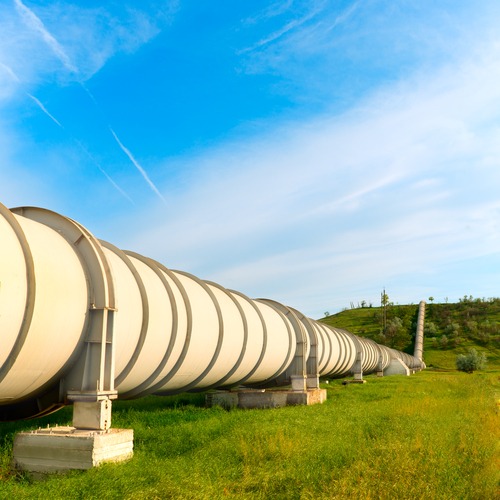Benefits-versus-politics battle rages over U.S. Northeast’s natural gas needs

New York Gov. Andrew Cuomo’s administration recently announced that construction would begin later this year on a new microgrid to power Empire State Plaza in Albany, a downtown complex housing several state government buildings and legislative offices. Along with a new cogeneration plant, the project could produce up to 90 percent of the 98-acre complex’s annual electric energy needs.
The project is slated to save the state $2.7 million in annual energy costs, cut down greenhouse emissions, decrease the New York’s carbon footprint, help fight climate change and bolster its efforts to “harden our vital facilities to withstand what Mother Nature throws our way,” Cuomo said in a statement.
The Albany plaza’s microgrid will have two 8-megawatt, clean-burning, natural gas-fired turbine generators.
Interestingly, the governor’s common practice of blocking new pipeline projects to transport that natural gas has come to be known as “The Wall of Cuomo.” This spring, for instance, Cuomo killed the Northern Access pipeline and in 2016 helped stop the Constitution Pipeline project — despite the state’s and the region’s continued use and increased need for natural gas, stakeholders say.
“This helter-skelter energy policy that our governor seems to espouse doesn’t make a lot of sense,” API New York Executive Director Karen Moreau told Daily Energy Insider on Thursday. API New York is a division of the American Petroleum Institute (API), the national trade association representing the oil and natural gas industry.
The Albany microgrid project is also “the most telling example of disconnect” between Cuomo’s actions and the natural gas needs facing consumers in the Northeast United States, she said.
“This is one of the most populated areas in the country and the energy needs here are significant,” Moreau said. “But the governor has made determinations over the last couple of years to appease those who are opposed to fossil fuels, and New York City in particular is home to some of the country’s largest environmental groups that wield a lot of power politically. So this is very much a political situation.”
And Cuomo’s politics continue to cost his constituents billions of dollars each year in energy costs, sources say.
“New England customers pay 50 percent more than anywhere else in the country for energy,” Moreau said. “Consumers continue to use and want more natural gas, but the governor is delaying cost savings from reaching the people who need low-cost energy the most.”
Cuomo’s own energy plan assumes significant growth in natural gas use, she pointed out, “but we can neither produce it nor transport it in our state.”
Reliable electric and natural gas
Accessing adequate amounts of natural gas for the six-state Northeast region’s natural-gas generators is a pressing challenge for ISO New England (ISO NE) this year, according to the electric grid operator’s 2017 Regional Electricity Outlook report.
Gordon van Welie, president and CEO of ISO NE, writes that on the coldest days of the year, natural-gas-fired power plants can’t always access adequate gas because natural gas transportation and storage infrastructure hasn’t kept pace with demand from the electricity sector.
“This is a real risk to reliability — nearly half the region’s current electric generating capability and roughly half the proposed new capability runs primarily on this fuel type,” van Welie writes in the report.
To fill the gap, generation is fueled instead by resources that run on nuclear power, oil and coal — resources that are starting to close down and leave the system because they’re less efficient, less profitable or both, he said.
“Replacing them will be even more natural-gas-fired generation, to a large extent,” van Welie writes.
While ISO NE attempts to offset some of the region’s reliance on natural gas by refining systems and market rules to integrate renewable resources, van Welie said the region is “decades away from installing enough renewable resources and grid-scale energy storage to allow for complete independence from fossil fuels.”
So for the foreseeable future, he said the Northeast region still needs resources like natural-gas-fired units.
They “can do what wind and solar resources cannot: make large contributions to meeting regional electricity demand; run in any type of weather and at any time of day; quickly change output levels; and provide essential grid-stability services,” he writes.
Additionally, the Northeast Power Coordinating Council said in a recent report that the region may need to rely on power imports from nearby regions to maintain reliability this summer following the May retirement of Dynegy’s Brayton Point coal-fired power station in Massachusetts.
Other coal, oil and nuclear sources of power generation are slated for shutdown by 2020, as well.
“Frankly, many folks don’t completely understand that electrical generation comes from many sources, but the preferred fuel in New England is natural gas,” Moreau said.
ISO NE reports that natural-gas-fired generation resources fueled 49 percent of the region’s electricity in 2016 and is the primary fuel source for more than 40 percent of regional capacity. Most of the time, these natural gas generators set the price for wholesale electricity. Pipeline constraints create spikes in both natural gas and wholesale electricity prices, ISO NE says.
“In contrast, when the region’s gas-fired generators have unconstrained access to natural gas, wholesale electricity prices tend to be low and competitive nationally,” the operator said.
The lack of natural gas pipelines in New York and the Northeast region, Moreau said, “has nothing to do with logic, the facts or the need that clearly exists. It’s all about politics.”
